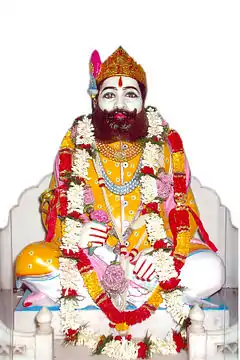Agrahari
Agrahari, Agraharee or Agarhari is an Indian and Nepali Vaishya community, claimed to be descendants of legendary king Agrasena.[2] Predominantly, they are found in the Indian state of Uttar Pradesh,[3] Madhya Pradesh, Jharkhand, Chhattisgarh and Terai region of Nepal.[4]
History
In 1916, Robert Vane Russell, an ethnologist of the British Raj period wrote, Agrahari, a sub caste of Bania found chiefly Jubbulpore district and Raigarh State. Their name connected with the cities with Agra and Agroha.[5]
William Crooke states that Agrahari claim partly a Vaishya and partly a Brāhmanical descent, and wear the sacred thread. Like that of the Agarwāla Banias their name has been connected with the cities of Agra and Agroha. There is no doubt that they are closely connected with the Agarwālas.[6]
In Chhattisgarh, Central Provinces of British India,[7] some of few Agrahari were Malgujars/Zamindars.[8] The ruler of Raigarh awarded the title Shaw to Agraharis. The title still continues.[9]
Sikhism in Agrahari
Most of the Agraharis follow Hinduism, although some are Sikhs. The majority of Agrahari Sikhs are found in the Eastern Indian state of Bihar Jharkhand and West Bengal. A View from Eastern India", that Agraharis converted to Sikhism during Mughal period by Guru Tegh Bahadur Ji, 9th Guru of the Sikhs. Mughal rulers were enforcing Hindus to convert to Islam, but Agraharis refused to convert to Islam and they accepted Khalsa Panth, led by Guru Tegh Bahadur Ji for protecting their life and religion.[10] Other legend says that Agrahari Sikhs are a community of Ahom converts to Sikhism from the time of 9th Guru Tegh Bahadur Ji’s travel to Assam. .[11] They are running several Gurudwara in Bihar and West Bengal and Jharkhand. The majority of these Sikhs are found in Sasaram, Gaya and Kolkata of Bihar and West Bengal. In Jharkhand they are found in Dumari Kalan and Kedli Chatti. Agrahari Sikhs not only came Eastwards of India, they are also found in the Indian State of Uttar Pradesh. . They belong to mainstream Sikhism as taught by the Sikh Gurus.
Surname, Gotra & title
Agrahari often use their community name as surname. However, many people using Gupta, Bania or Baniya, Patwari or Vanik or Banik, Shaw and Vaishya or Vaishy or Vaish or Baishya or Baish.[12] They have a common gotra, the Kashyap.[13]
Reservation
No Reservation of Agrahari Community in India , They commonly come in general catageory.
References
- Narath, Radhika (22 September 2017). "People still carry out Maharaja Agrasen's ideals". Daily Pioneer.
- Kumar Suresh Singh; Amir Hasan; Hasan, Baqr; Raza Rizvi; J. C. Das (2005). People of India: Uttar Pradesh , Voume 42, Part (illustrated ed.). Anthropological Survey of India. p. 66. ISBN 978-81-73041-14-3.
- Lalit Mohan Sankhdher (1974). Caste Interaction in Village Tribe: An anthropological Case Study of the Tribes in Dhanaura Village in Mirzapur District of Uttar Pradesh. K. P. Publications. p. 10–1.
- Shibani Roy; S. H. M. Rizvi (2002). Encyclopaedia of Indian surnames. B.R. p. 6. ISBN 978-81-7646-247-1.
- Robert Vane Russell (1916). The Tribes and Castes of the Central Provinces of India, Volume 1.
- R.V. Russell; Rai Bahadur Hira Lāl (1916). The Tribes and Castes of the Central Provinces of India (Volume II).
- Richard Gabriel Fox (1969). From Zamidar to ballot box: community change in a north Indian market town. Cornell University Press. p. 286.
- Richard Gabriel Fox (1969). From Zamidar to ballot box: community change in a north Indian market town. Cornell University Press. p. 83.
- Richard Gabriel Fox (1969). From Zamidar to ballot box: community change in a north Indian market town. Cornell University Press. p. 90.
- "The identity of North-East Sikhs". Himadri Banerjee. 24 August 2003.
- "Away from Punjab - the south Indian Sikhs". Zee News. 18 October 2011.
- Kumar Suresh Singh (1996). Identity, Ecology, Social Organization, Linkages and Development Process: a Quantitative Profile. Anthropological Survey of India. p. 18.
- Kumar Suresh Singh (2008). People of India, Volume 16, Part 1. Anthropological Survey of India. p. 50. ISBN 9788170463023.

